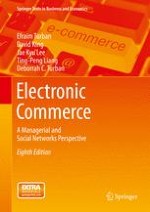2015 | OriginalPaper | Buchkapitel
10. E-Commerce Security and Fraud Issues and Protections
verfasst von : Efraim Turban, David King, Jae Kyu Lee, Ting-Peng Liang, Deborrah C. Turban
Erschienen in: Electronic Commerce
Aktivieren Sie unsere intelligente Suche, um passende Fachinhalte oder Patente zu finden.
Wählen Sie Textabschnitte aus um mit Künstlicher Intelligenz passenden Patente zu finden. powered by
Markieren Sie Textabschnitte, um KI-gestützt weitere passende Inhalte zu finden. powered by
